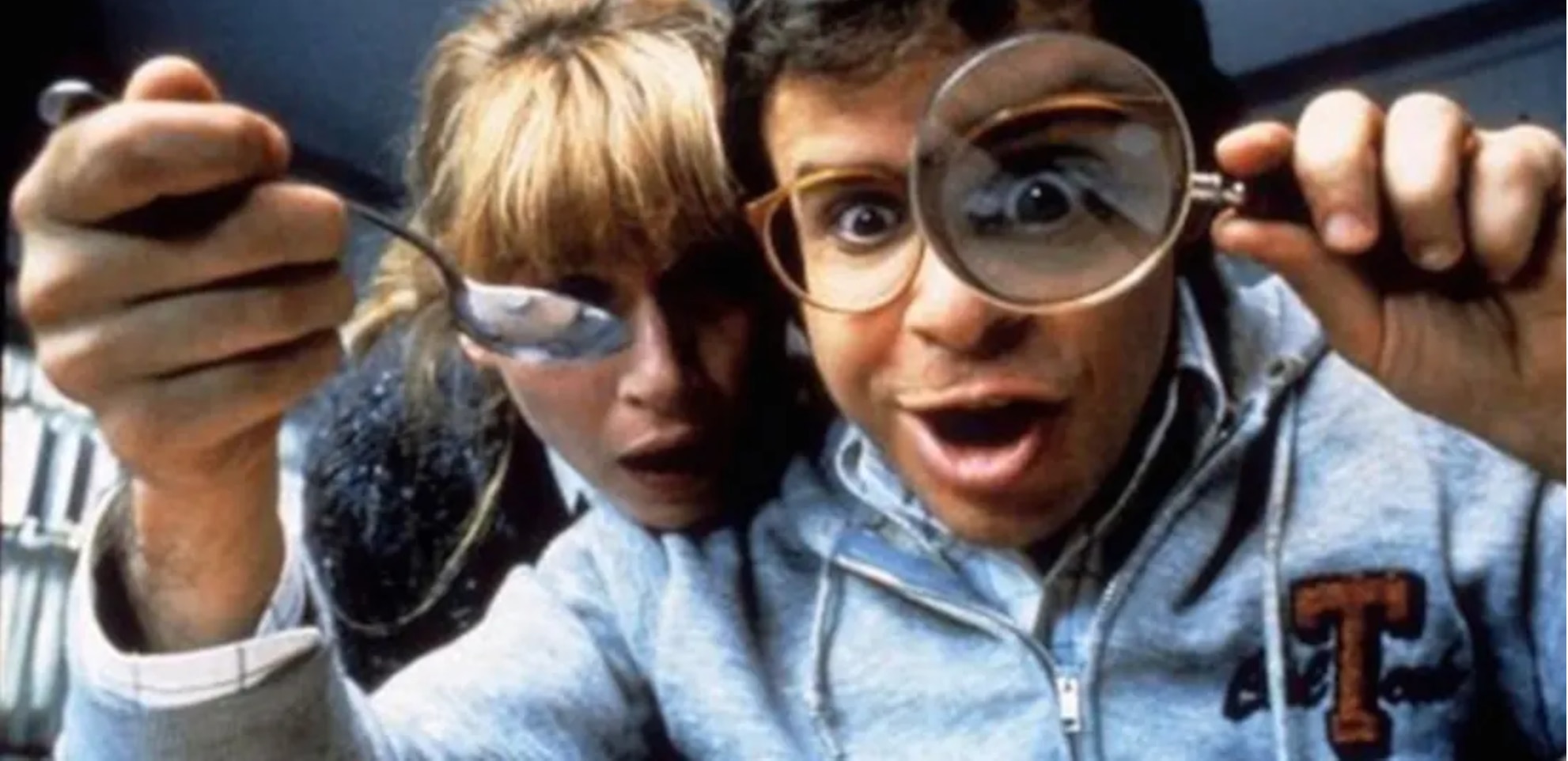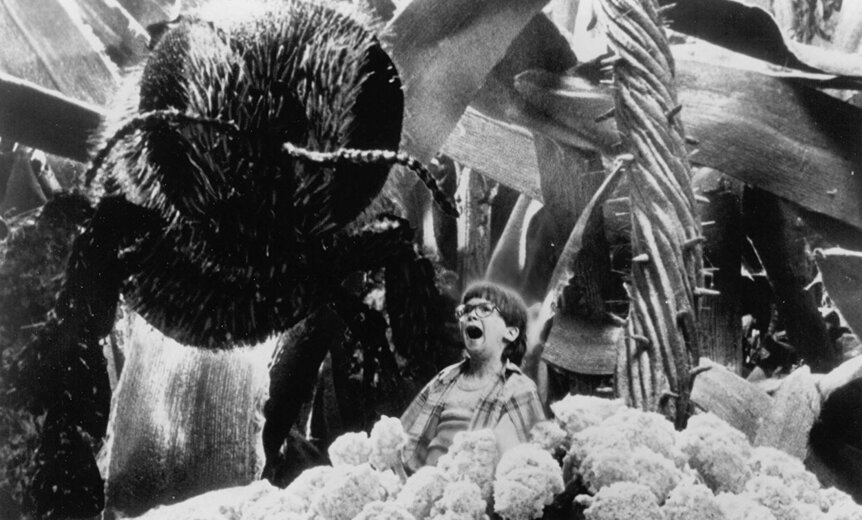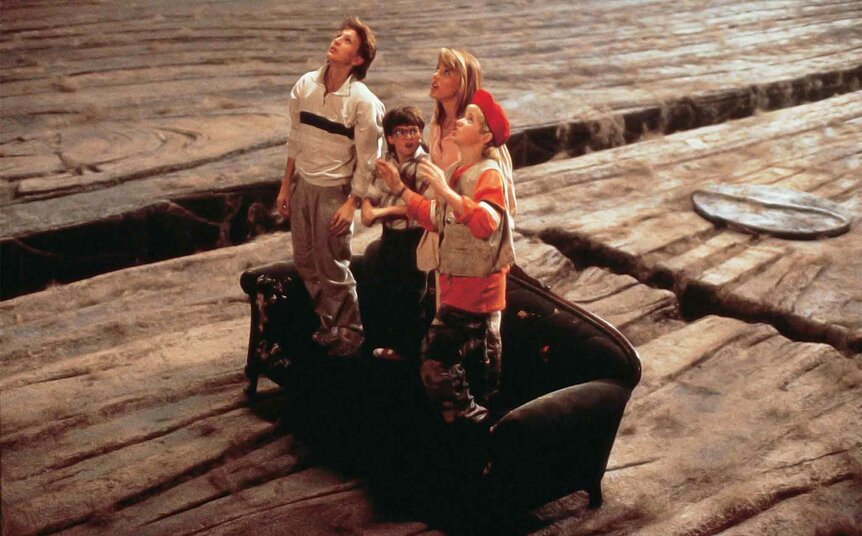Create a free profile to get unlimited access to exclusive videos, sweepstakes, and more!
Behind the scenes of Honey, I Shrunk the Kids, a surprise smash horror movie for kids

Stuart Gordon and Brian Yuzna had spent the better portion of the '80s working together on modest-sized, humor-tinged Lovecraftian body horror pics like 1985's Re-Animator. While well-received, they weren't quite movies they could show their young children, a point they were discussing during a backyard family barbecue in late 1985.
Gordon suggested that they make a movie that they could screen for their kids. Yuzna, taking stock of the idyllic suburban setting, offered up a quaint childhood memory that would soon become the spark for something much bigger (and smaller).
"I looked around and said, 'Well, when I was a kid, I used to play, get right down on the grass level and imagine being real small and riding on a beetle or an ant or a bee,'" Yuzna recalled in a recent conversation with SYFY WIRE. "He jumped right on that, and we immediately started inventing a story about some kids that get shrunk by their dad, who's an inventor."
It was a productive day in the backyard, as Yuzna remembers churning out a lot of the major story points and gimmicks for a movie they would tentatively title Teeny Weenies. They decided the dad would have a shrinking machine, that it would be activated by a baseball that crashes through a window, and that the kids would be thrown out with the trash. "The whole story was about getting home," Yuzna remembers, "which is really the story of a lot of movies."
They even discussed casting and producing their hypothetical movie. Stuart suggested Fred MacMurray, the star of kids flicks like The Shaggy Dog and the original Flubber, play the scientist in a movie that would be produced by Disney. The director figured he could get a meeting at the studio, then in the beginning stages of a rebirth, because he'd been working in theater for years and was represented by a powerful agent. With a plausible path to production, the duo hashed out the rest of the movie on a yellow legal pad during a plane trip back to L.A. in January 1986, then took it to the House of Mouse.
One meeting with producer David Hoberman went particularly well, which bought them time with Disney bigwig Jeffrey Katzenberg, who was heading up the film unit's revival. It went well, but there was one request in particular that seemed pretty non-negotiable.
"I remember at the lunch, Katzenberg said, 'But we got to change the title. [Teeny Weenies] sounds like a low budget porn movie,'" Yuzna says. "I don't know who came up with the title Honey, I Shrunk the Kids, but it certainly turned out to be a good one."
That's an understatement; the movie, directed by Joe Johnston and starring Rick Moranis as the mad scientist father who shrinks his two kids and two neighbors, made over $200 million at the box office in 1989 and launched a franchise that will soon be rebooted on the streaming service Disney+. With June 23 marking the 30th anniversary of the movie's release, SYFY WIRE spoke with Yuzna all about its inception, conception, and legacy.
It was ultimately a hit, but I think that came as a bit of a surprise. How much did Disney prioritize this movie while it was being made?
This was a time when Disney was ... I wouldn't say on the ropes, but there was talk about it being broken up. This wasn't meant to be an expensive movie, it was meant to be a cheap, a very low budget movie. For that reason, our offices weren't even on the lot, and the movie was actually shot in Mexico.
A lot of people think that it's such a departure from horror, but I think that fantasy, with different lighting, is horror. You can go either way with it. 7th Voyage of Sinbad, it's a horror movie, but it's a fantasy movie. You can lighten up or darken the monsters. I think they're on a continuum. A lot of horror is just dark fantasy.
You handed it off at some point, right? To a screenwriter.
Yeah, we had sketched out the story, written the treatments. Then we needed a writer, and we proposed Ed Naha, who had worked on the second movie that Stewart and I did together called Dolls. Ed had written that screenplay, and so that's the way that we knew him. Stewart especially felt very comfortable with Ed because even Dolls was basically a fairy tale. We developed the script up until about '87, when it was ready to be shot. We developed a script with Ed and David Hoberman.
We designed all the big effect scenes. Sometimes there were certainly back-and-forths with the studio. For example, at one point, they wanted it to leave the backyard, and maybe go to a mall or something. We weren't into that. I think they actually did that maybe with the [Honey I Shrunk the Kids] TV show. The idea that it's all in your backyard, you never leave the backyard. Well, the adventures in your backyard, that's pretty classical.
We did try to take a step in going out of the backyard. We never got it to the mall or anything, but we did try a scene where they're on the dog, and the dog gets grabbed by the dog catcher. The dog gets thrown into the truck of the dog catcher that has a lock on it. I think the little kids have to get inside the lock to get free. There were also big issues about the budget, major ones.
Because literally everything had to be built, you couldn't shoot on a green screen and deal with it in post-production.
We brought on Tom Smith from ILM, who had worked on Star Wars and Indiana Jones movies. One of the great things about being over at a studio lot was we could just order up any movie that had to do with little people or big bugs, which is mainly that we wanted. We would just say, "We want to see The Incredible Shrinking Man. We want to see The Mysterious Island, where they go in the balloon and they end up on an island with giant crabs. They get inside a beehive, which was one of the things we were interested in. We watched anything that had to do with that type of effects.
At some point, we had to decide how big the kids were going to be and what kind of ant [they would ride]. Every time you needed something, they provided top-notch people. I think we settled on the idea that the kids should be about three-quarters of an inch tall. Originally, the idea was, could they be as big as two inches tall? Because that would be pretty good? Then you have a hard time riding an ant because there's no ant that big. You can't ride a bee. It was kind of trying to find the right size for the story.
You simplified the story in a lot of places to deal with budget too, right?
The business with the dog catcher, that went by the wayside pretty quickly because of the budget. Once you start looking at all these effects sequences, the budget starts just being impossible. At the end when they get in the house, I think at one point they had to get across from the table to somewhere and they make a slingshot from a sewing kit with a needle, and they go flying across. That started being way, way complicated to do.
I think I suggested the idea of the Cheerios instead. "Hey, just get them in the bowl of Cheerios. It'd be fun." It's a much simpler gag, because you can build a big Cheerio, you know what I mean? There's no background needed.
In our original version, the father was laughed at by the scientific society. At the end, he comes back and they laugh at him again, but the ant comes in and the ant is a giant and the kids are riding it. That was the ending. At one point, I think Stuart decided that the ant had to die. At that point, I think there was some concern that maybe Stuart was reverting to his horror roots, because it seemed like a dark thing to do. Still, people will say, "Oh, why did that ant have to die?" It's so appropriate, because if you don't have the pathos... a kids movie has to have the dark thing, too.
It may have cost a lot, but the upside of practical effects is that the set looked like a ton of fun.
We built the sets. I moved to Mexico, and we built the sets. They were cute. It was really fun to watch the set workers. They had to build every blade of grass, and it would take more than one person to carry it. It was kind of funny to watch. It was just a few weeks before shooting, Stuart got ill and had to quit the project. At that point, everything was stopped while an insurance claim was put in. Then, Joe Johnston was brought in. Of course, he had his own producer, so Stuart and I took a step back and Joe Johnston shot the movie.
Were you happy with the way it turned out?
I think the movie turned out great. Of course, I'm prejudiced, but I think Stuart would have done a better job. I mean, I'm a big fan of Stuart as a director. But you can't argue with success. I think that ultimately, of what we developed and prepared, I'd say the movie is 80% the same. There are a few things that changed. One I'm not real big on and the other I think was just great.
The thing that was contributed by the new writer that I think was just great was the idea that the wacky inventions of Szalinski, that he had all those stupid inventions that didn't work. I know it's a direct lift from Gremlins. It's still fun, and it shows him as a wacky character. He doesn't have to act wacky, you know what I'm saying? He's already got the glasses and that befuddled look and everything, but the idea that he's always inventing something is, I think, a good one. Where I really think it paid off, for me, was that that made it possible for him to have that weird contraption that suspended him over the backyard.
The thing that I wasn't super enthused about was the [giant] turkey at the end. That didn't have quite the fun that I kind of would have hoped, but, hey, it all works.
Have you heard they're making a new TV series based on the concept?
I read that. I hope they use the original characters, because then I'll get paid.
Beyond that, how do you feel about it? They made a TV series in the '90s, do you think they should make another?
I know some people think that things that they love should never get remade. I don't feel that way. I think movies have, from the very beginning, always been remade and always been sequelized and prequelized. It's nothing new. I'm not against it. I get why.
















